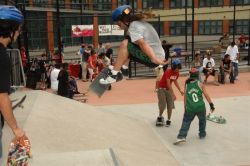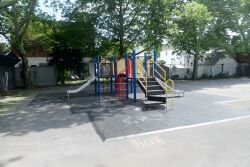Bruckner Playground
Bruckner Playground
Henry Bruckner (1871-1942), United States Congressman and long-time Bronx Borough President, was born in the Bronx on June 17, 1871. He attended public schools, and at age 19, took a job designing silver for the Gorham Manufacturing Company in Providence, Rhode Island. Bruckner embarked on a business venture with his brother when he returned to the Bronx in 1892. Together they founded Bruckner Beverages, which would soon be the city’s largest soda water bottler, located on 410 East 161st Street.
Henry Bruckner began his political career as a state legislator in 1900. The following year he was appointed Commissioner of Public Works, a position he held until his election to the United States Congress in 1912. Bruckner also served on the Committee of Public Buildings and the Merchant Marine, an organization of privately owned and operated commercial vessels registered with the federal government that sought to expand the nation’s wealth through trade and to transport provisions abroad in wartime. A staunch Bronx Democrat, Bruckner became Bronx Borough President in 1918, and maintained a close affiliation with the Tammany Hall political machine.
The Tammany Society, founded in 1789 by William Mooney, began as a nationwide patriotic organization intended to counteract the perceived elitism of the Federalist Party. Although the Society made major contributions to Thomas Jefferson’s successful 1800 bid for the presidency, Tammany soon lost its national standing. It became a bulwark of New York politics, synonymous with the local Democratic Party from 1855 until 1932. That year, the state legislature released the results of their investigations into Tammany corruption. Following the resignation of Mayor Jimmy Walker, Judge Samuel Seabury ordered the removal of Henry Bruckner from his position as Bronx Borough president. Bruckner refused to resign, but his 33-year political career ended the next year when Bronx Democratic leader Edward J. Flynn refused to support Bruckner’s re-election bid. Bruckner died of chronic nephritis on April 14, 1942, in his Bronx home at 858 Grant Avenue.
This playground is named for Henry Bruckner because of its proximity to the Bruckner Expressway and Interchange. In the late 1940s, Eastern Boulevard, once a major thoroughfare that provided access to the Triborough Bridge, was widened and renamed Bruckner Boulevard. In 1951, Parks Commissioner Robert Moses proposed his plans to transform the boulevard into an expressway that would run from the Triborough Bridge to Pelham Bay Park, connecting with other major north-south routes along the way. Construction began in 1957 and the expressway was opened to the public in parcels throughout the following decade. In 1972, the completed $68 million Bruckner Interchange replaced the antiquated Bruckner Traffic Circle at the intersection of the Hutchinson River Parkway, Cross Bronx Expressway, and Bruckner Expressway. The Interchange, which lies approximately five hundred feet west of this site, provides important access to the Throgs Neck and Bronx-Whitestone Bridges from all three routes.
Bruckner Playground is bounded by Lafayette Avenue to the west and Swinton Avenue to the north, with the service road to the Cross Bronx Expressway running along the southeastern side, and enclosing the land in an irregular triangle. The parkland is adjacent to P.S. 101 and serves as its schoolyard. Parks and the Board of Education acquired the property in 1955 for the construction of a jointly operated playground adjacent to the newly built school, then known as J.H.S. 101. The $157,800 construction plans required the elimination of portions of Huntington and Brinsmade Avenues. The J.H.S. 101 playground was opened to the public on September 25, 1958. The name was later changed to Bruckner Playground by Commissioner Stern. Bruckner Playground currently features handball and basketball courts that are enjoyed by the school and community.
Check out your park's Vital Signs
Clean & Safe
Green & Resilient
Empowered & Engaged Users
Share your feedback or learn more about how this park is part of a
Vital Park System









